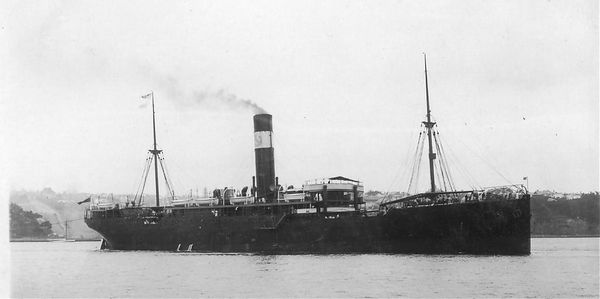HMAT A2 Geelong
From Our Contribution
 en.wikipedia.org | |
| History | |
|---|---|
| Name | HMAT A2 Geelong |
| Builder/Built | 1904 Barclay Curle, Whiteinch, Glasgow |
| Type | Passenger Liner (twin screw) |
| Displacement | 7,954 tons |
| Speed | 12 knots |
Contents
Remarks
Originally launched as 'Australia', but on completion her name was changed. Built for W Lund's Blue Anchor Line, she accommodated 90 saloon and 450 third class passengers and was used on the Britain - Australia immigrant route. Leased in August 1914 by the Commonwealth for troop transport duties, and underwent conversion in Melbourne to carry 62 officers and 1539 men. She made at least four completed journeys from Australia with troops aboard.
On 1 Jan 1916 she collided with "SS Bonvilston" in the Mediterranean and sank approx. 100 miles (165 km) north of Alexandria with general cargo. The crew was rescued.
The Geelong, well known to many Australians, first as a Lund Blue Anchor Liner, and then as a member of the P. and O. Branch Service, left Port Said in the early morning of New Year's Day, 1916. For the first twelve hours all went well, but as evening drew on the sky was overcast and dark, with occasional lightning, but otherwise the night was clear. Special instructions had been given to proceed at full speed without lights, and this is of importance as it resulted in a curious decision when the Court eventually dealt with the question of responsibility and liability for the disaster. Undoubtedly on the Geelong a very careful lookout was kept, the Master,Chief, and Fourth Officers were on duty on the bridge, with a lookout man on the forecastle head and another with binoculars in the crow's nest. The gun crew were also keeping a lookout aft.
Shortly after 7 p.m. a black form, as if of a vessel, was seen on the starboard bow. Neither the nature of the vessel, which was proceeding without lights, like the Geelong, nor its direction, could be ascertained owing to the darkness, and in view of the Admiralty orders, full speed was of course kept. Very shortly afterwards it was seen that the vessel was a steamer crossing the course of the Geelong, and coming towards her. The engines of the Geelong were at once ordered full speed astern, and three blasts were blown on her whistle. The helm was put hard a-starboard, but the other steamer continued to approach, and presently struck the Geelong a heavy blow on the starboard side, in the wake of the engine room, with the result that the internal lights went out almost immediately, and that none of the ship's papers or the effects of the crew could be saved. All aboard, however, managed to take to the boats before the ship sank, and were conveyed by the Bonvilston, which had come out of the encounter comparatively lightly, to Alexandria.[1]
Soldiers carried
Hobart to Alexandria 20 Oct - 10 Dec 1914
Fremantle to Port Suez 7 June - ? July 1915=
Adelaide to Port Suez 18 November - 18 December 1915
Ship arrived 7:30 am 14 Dec 1915, disembarked 18 Dec 1915.
- George Bett post WW1
- Albert George Bullock
- Percy Goodall
- Bertie Greenfield
- Walter Robert Hayes
- William Heath
- Patrick Wilford Kelly
- George Wales McGillivray
- William Archer Waller
- ↑ Sea Transport of the AIF, Greville Tregarthen, Naval Transport Board